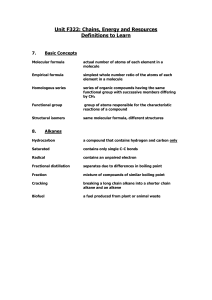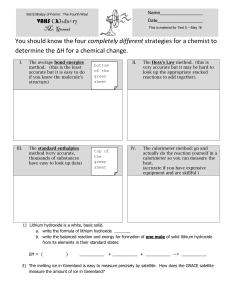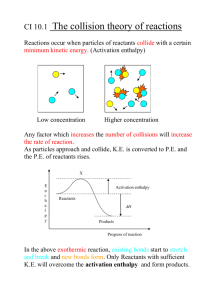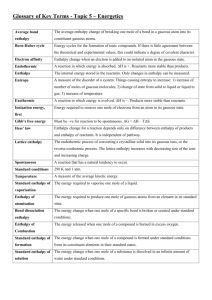THERMOCHEMISTRY Chemistry CHEM 213W
advertisement
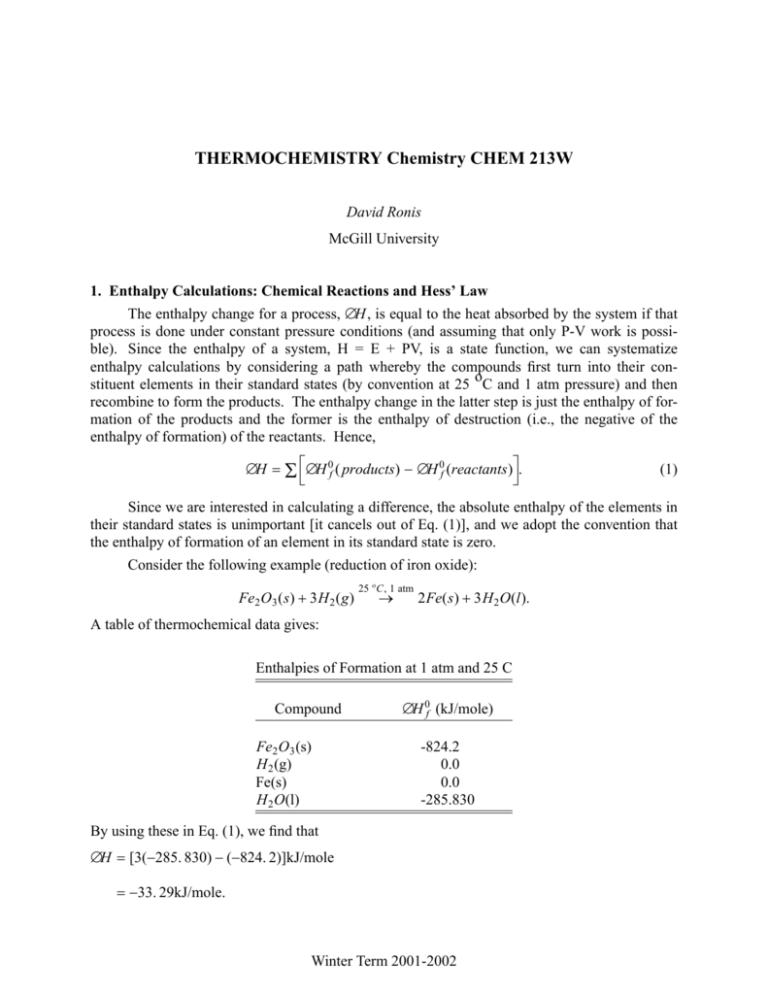
THERMOCHEMISTRY Chemistry CHEM 213W David Ronis McGill University 1. Enthalpy Calculations: Chemical Reactions and Hess’ Law The enthalpy change for a process, ∆H, is equal to the heat absorbed by the system if that process is done under constant pressure conditions (and assuming that only P-V work is possible). Since the enthalpy of a system, H = E + PV, is a state function, we can systematize enthalpy calculations by considering a path whereby the compounds first turn into their constituent elements in their standard states (by convention at 25 oC and 1 atm pressure) and then recombine to form the products. The enthalpy change in the latter step is just the enthalpy of formation of the products and the former is the enthalpy of destruction (i.e., the negative of the enthalpy of formation) of the reactants. Hence, ∆H = Σ ∆H 0f ( products) − ∆H 0f (reactants). (1) Since we are interested in calculating a difference, the absolute enthalpy of the elements in their standard states is unimportant [it cancels out of Eq. (1)], and we adopt the convention that the enthalpy of formation of an element in its standard state is zero. Consider the following example (reduction of iron oxide): Fe2 O3 (s) + 3H 2 (g) 25 o C, 1 atm → 2Fe(s) + 3H 2 O(l). A table of thermochemical data gives: Enthalpies of Formation at 1 atm and 25 C Compound Fe2 O3 (s) H 2 (g) Fe(s) H 2 O(l) ∆H 0f (kJ/mole) -824.2 0.0 0.0 -285.830 By using these in Eq. (1), we find that ∆H = [3(−285. 830) − (−824. 2)]kJ/mole = −33. 29kJ/mole. Winter Term 2001-2002 Thermochemistry -2- Chemistry CHEM 213W Note that the calculated enthalpy change depends on how the reaction was written. For example, if we wrote 25 o C, 1 atm 3 3 1 → Fe(s) + H 2 O(l), Fe2 O3 (s) + H 2 (g) 2 2 2 then ∆H = −16. 65 kJ/mole. 2. Measuring ∆H 0f There are a number of ways in which to measure the enthalpy of formation of a compound; here are two. The most obvious is to simply carry out the formation reaction from the constituent elements in their standard states in a constant pressure calorimeter (recall that ∆H = Q p ). For example, consider the combustion of graphite to form carbon dioxide C(graphite) + O2 (g) 25 o C, 1 atm → CO2 (g). The heat released in this reaction is −∆H 0f (CO2 ), since the standard enthalpy of formation of the reactants is zero. For this method to work, two conditions must be met: 1) the reaction goes to completion and 2) only one product is formed. Thus, the reaction C(graphite) + 2H 2 (g) 25 o C, 1 atm → CH 4 (g) is not suitable for this method since it doesn’t readily go to completion and we get a complicated mixture of hydrocarbons. In order to get around this, note that it is often possible to burn something to completion (and measure ∆H combustion , the heat released). Thus consider CH 4 (g) + 2O2 25 o C, 1 atm → CO2 (g) + 2H 2 O(l). Equation (1) gives ∆H combustion = ∆H 0f (CO2 (g)) + 2∆H 0f (H 2 O(l)) − ∆H 0f (CH 4 (g)). The standard enthalpies of formation of carbon dioxide and water can be measured using the first method; hence, once we measure the heat of combustion, the only unknown is the standard enthalpy of formation of methane (CH4) and a little algebra gives: ∆H 0f (CH 4 (g)) = ∆H 0f (CO2 (g)) + 2∆H 0f (H 2 O(l)) − ∆H combustion . = [−398. 51 + 2(−285. 83) − (−890. 36)]kJ/mole = −74. 81kJ/mole. In general, in order to measure the enthalpy of formation, all you need to to is find any reaction where all but one of the standard enthalpies of formation are known and where the reaction goes to completion. These sorts of manipulations are valid because the enthalpy is a state function, and are referred to as Hess’s law. Also note that the same arguments could be made for the energy changes (under constant volume conditions). Winter Term 2001-2002 Thermochemistry -3- Chemistry CHEM 213W 3. Reactions at Different Temperatures: Kirchoff ’s Law What happens if the temperature at which you perform the reaction (either at constant P or V) is different than that of your table of enthalpies of formation. Since the enthalpy is a state function, an alternate path can be found whereby the enthalpy change, calculated using the temperature of your table, can be used. Consider the constant pressure case depicted below Reactants Products I (T ) 1 II Reactants Products (T ) 0 The enthalpy change for the reaction at T 1 is equal to the enthalpy change at T 0 plus the enthalpy change for paths 1 and 2. However, on 1 or 2, only the constant pressure heating or cooling of the reactants or products is performed (i.e., no chemical reaction takes place). Since the constant pressure heat capacity, C P was defined as CP ≡ ∂H , ∂T P,N the incremental heat absorbed by the system on 1 or 2 is C P dT . Integrating gives: ∆H 1 = T0 T1 T1 0 ∫ C P (reactants)dT = − T∫ C P (reactants)dT and T1 ∆H 2 = ∫ C P ( products)dT . T0 Adding the contributions together gives T1 ∆H(T 1 ) = ∆H(T 0 ) + ∫T C P ( products) − C P (reactants). 0 This is known as Kirchoff’s law. What changes must be made for the energy? Consider our example of the reduction of Fe2 O3 . What is the enthalpy change at 358K? We will assume that the heat capacities are constant over the temperature range 298 - 358 K. Winter Term 2001-2002 Thermochemistry -4- Chemistry CHEM 213W Constant Pressure Heat Capacities at 1 atm and 25 C Compound C P (J/mole/K) Fe2 O3 (s) H 2 (g) Fe(s) H 2 O(l) 103.8 28.8 25.1 75.3 Note that elements in their standard states do not have zero heat capacities. Using the data in the table, and the result of our earlier calculation gives ∆H rxn (358K ) = −33. 29 + [2(25. 1) + 3(75. 3) − 103. 8 − 3(28. 8)][358 − 298] 1000 = −28. 1kJ/mole. Note that no change in phase occurred when we cooled (heated) the reactants (products). What changes would have to be made if the reaction was carried out at 400 K? 4. Bond Energies A useful, albeit very approximate, way to calculate enthalpy changes in chemical reactions is through the concept of bond energies. Consider the following reaction CH 4 → CH 3 + H; i.e., one C-H bond is broken. Experimentally, ∆H for this reaction is 102 kcal/mole. Similarly, ∆H = 96 kcal/mole for C 2 H 6 → C 2 H 5 + H. A survey of such reactions will show that the heat required to break a single C-H bond is in the range 96-102 kcal/mole. We can thus assign 98 kcal/mole as an average bond energy for the C-H bond. Similar tends are observed in the bond strength of other types of bonds, and the results are summarized in the following table Winter Term 2001-2002 Thermochemistry -5- Bond H-H C-C C=C C ≡C N-N N≡N O-O O=O Cl-Cl Br-Br I-I Chemistry CHEM 213W Average Bond Energies Energy Energy Bond (kcal/mole) (kcal/mole) 103 C-H 98 80 N-H 92 145 O-H 109 198 Cl-H 102 37 Br-H 87 225 I-H 71 34 C-Cl 78 117 C-N 66 57 C≡N 210 45 C-O 79 35 C=O 173 How can this be used? Consider the hydrogenation of ethlyene: H 2 C = CH 2 + H − H → H 3 C − CH 3 . At the molecular level, we break one H-H and one C=C bond, and form one C-C and two C-H bonds. The energy change is just the net energy left in the molecule in such a process. From the table, the bond breaking steps take 145+103=248 kcal/mole. The bond formation will give off 80+2(98)=276 kcal/mole. Hence the net energy change in the system is 248-276 = -28 kcal/mole. To get the enthalpy change, note that at constant pressure, ∆H = ∆E + P∆V . For this reaction, all reactants and products are gases. If we assume that the gases are ideal, we can compute ∆V ; i.e., RT ∆N . P ∆V = Here ∆N = −1 and thus ∆H = −28 − 1. 9872 × 10−3 kcal/mole/K × 298K = −28. 6 kcal/mole. (Note that here the difference between ∆H and ∆E is relatively small). The correct answer is -32.7 kcal/mole. Thus while, the bond energy method is not exact it gives a reasonable estimate. The reason for the discrepancy is the assumption that the bond energy doesn’t depend on what other bonds are present in the molecule--in general this is not true. 5. Some Manipulations Involving Thermodynamic Functions 5.1. The relationship between C P and CV We know that CV = ∂E ∂T N ,V Winter Term 2001-2002 Thermochemistry -6- Chemistry CHEM 213W and that CP = ∂H . ∂T N ,P How these two quantities are related is a good exercise in manipulating thermodynamic functions. Since H=E+PV, CP = ∂V ∂E +P , ∂T N ,P ∂T N ,P where the last derivative should be recognized as V α , where α is the thermal expansion coefficient, α ≡ 1 ∂V . V ∂T N ,P If we view the energy as a function of N,V,T, ∂E ∂E ∂V ∂E = + ∂T N ,P ∂T N ,V ∂V N ,T ∂T N ,P = CV + α V ∂E . ∂V N ,T Hence, ∂E C P − CV = P + αV ∂V N ,T = VT α 2 β , where β ≡− 1 ∂V V ∂P T ,N is the isothermal compressibility, and where the last equality will be proven later. The compressitility must be positive (i.e., things get smaller when squeezed) and this implies that C P ≥ CV . For an ideal gas, Joule showed that the internal energy per mole did not depend on the volume. In this case, C P − CV = α PV = R. 5.2. The Joule-Thompson Experiment Consider the following adiabatic (i.e, Q=0) process, whereby a gas is squeezed through a porous, rigid plug Winter Term 2001-2002 Thermochemistry -7- Chemistry CHEM 213W P1 P2 T1 P1 V1 T2 P 2 V2 Porous Plug Fig. 1. The Joule-Thompson Experiment Since, by assumption, Q=0, ∆E = E(P 2 , V 2 ) − E(P 1 , V 1 ) = −W = P 1V 1 − P 2V 2 . By rearranging this expression we show that E(P 1 , V 1 ) + P 1V 1 = E(P 2 , V 2 ) + P 2V 2 ; i.e., the enthalpy, H is constant in the Joule-Thompson expansion. In practice, large temperature changes can be obtained in this type of expansion (which can be used in designing a refrigerator). The key parameter is the so-called Joule-Thompson coefficient µ JT ≡ ∂T . ∂P H,N (2) In order to express µ JT in terms of more readily measurable quantities, note that ∂ f ∂x y ∂y =− , ∂x f ∂ f ∂y x which is sometimes known as the "cyclic rule" or "implicit function differentiation." It is proved by noting that df = ∂ f ∂ f dx + dy, ∂y x ∂x y setting df=0, and by solving for the ratio dy/dx. By using the cyclic rule on Eq. (2), we find that µ JT ∂H ∂P T ,N =− ∂H ∂T P,N Winter Term 2001-2002 Thermochemistry -8- =− 1 ∂H C P ∂P N ,T =− V ∂E 1 − β P + CP ∂V N ,T =− V β V (C P − CV ) = − 1− [1 − α T ], Cp αV CP Chemistry CHEM 213W where the second to last equality follows when the definition of the enthalpy in terms of the energy is used and the manipulations used in calculating C P − CV are repeated. β is the isothermal compressibility. Note that the Joule-Thompson coefficient vanishes for an ideal-gas. Winter Term 2001-2002




